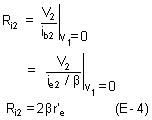Differential Input Resistance:
Differential input resistance is defined as the equivalent resistance that would be measured at either input terminal with the other terminal grounded. This means that the input resistance Ri1 seen from the input signal source v1 is determined with the signal source v2 set at zero. Similarly, the input signal v1 is set at zero to determine the input resistance Ri2 seen from the input signal source v2. Resistance RS1 and RS2 are ignored because they are very small.
Substituting ie1,
Similarly,
The factor of 2 arises because the re' of each transistor is in series.
To get very high input impedance with differential amplifier is to use Darlington transistors. Another ways is to use FET.
Output Resistance:
Output resistance is defined as the equivalent resistance that would be measured at output terminal with respect to ground. Therefore, the output resistance RO1 measured between collector C1 and ground is equal to that of the collector resistance RC. Similarly the output resistance RO2 measured at C2 with respect to ground is equal to that of the collector resistor RC.
RO1 = RO2 = RC (E-5)
The current gain of the differential amplifier is undefined. Like CE amplifier the differential amplifier is a small signal amplifier. It is generally used as a voltage amplifier and not as current or power amplifier.


